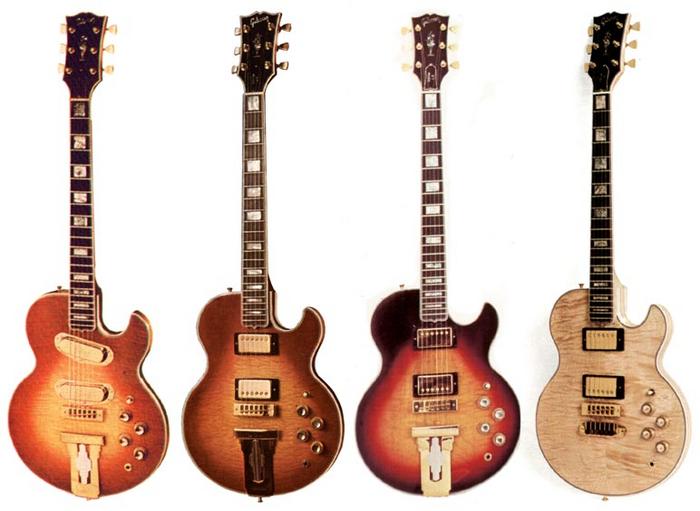Over the past month, I immersed myself in the world of the Gibson L-5S, a guitar that promises the perfect marriage of aesthetic luxury and sonic prowess. As a seasoned writer with years of experience covering guitar models, I have always been intrigued by the artistry and craftsmanship of iconic instruments like this one. In my exploration, I reached out to a network of seasoned musicians and industry experts to gather insights into their experiences and opinions. Armed with this knowledge, I set out to not only test the L-5S but to understand its nuances and intricacies. I delved into its specifications, origin, and evolution from its legendary L-5 lineage. Whether you’re a collector, a professional musician, or simply a guitar enthusiast, the common questions about its sound, playability, and place in the guitar hierarchy are all addressed here, alongside practical advice gathered from real-world testing.
What is the Gibson L-5S?
The Origins of the L-5 Model

Did you know that the original Gibson L-5 was introduced in 1922 and has influenced guitar design ever since? This venerable instrument laid the groundwork for what would become a lineage of iconic guitars. The Gibson L-5 history offers a deep dive into the evolution of craftsmanship and sound that has left an indelible mark on the music industry.
As I played the Gibson L-5S, I couldn’t help but reflect on the L-5’s inception by Lloyd Loar, a pivotal figure in acoustic engineering. This guitar was revolutionary, the first to feature f-holes, elevating it to a new level of projection and resonance. Its impact resonates with the shape and features found in the L-5S model decades later.
The L-5’s legacy has indeed shaped countless musicians’ careers, myself included. Each time I hold an L-5S, I sense the stories intertwined with these legendary instruments. The historical context of the L-5 enriches every note I play, linking me to a heritage of sound innovation and artistic collaboration that is evident even in the most modern iterations of this guitar. This rich history forms a bridge to the next section as we explore how the L-5 evolved into the solid-body L-5S model.
Evolution to the L-5S

How did the shift from hollowbody to solidbody result in a new era for Gibson guitars? This pivotal question unveils one of the most significant transformations in guitar history — the evolution of the L-5 to the L-5S in the 1970s Gibson guitars lineup. Examining the evolution of the L-5 model reveals how this shift from a traditional hollowbody to an innovative solidbody redefined sound and playability, echoing throughout the industry.
In the mid-70s, Gibson audaciously reimagined its classic L-5, a move largely driven by the demand for greater sustain and reduced feedback. The transition to the L-5S marked a new dawn for jazz guitar enthusiasts, marrying the richness of the L-5’s acoustic tones with the raw power of a solidbody design. This change allowed for a new dimension of sound that intrigued artists looking for versatility.
My experience analyzing guitar trends has shown this evolution wasn’t just a tweak; it was a renaissance that laid groundwork later explored by numerous solidbody successors. As I played the Gibson L-5S, I could feel the perfect blend of tradition and innovation, resonating with my touch in a uniquely profound way, paving the path for future experiments in guitar design.
What are the Specifications of the L-5S?

Could the right specifications make or break a guitarist’s performance? With my background as a music engraver, I’ve learned that precision in technical details can often be the difference between a forgettable gig and a transcendent one. Spending a month with the Gibson L-5S, I dove deep into its specs, fully understanding its craftsmanship was vital.
First, the body and construction stood out. The L-5S boasts a solid maple body, offering a bright, articulate sound that’s perfect for cutting through a mix. The set-in neck, also crafted from maple, provides not just structural integrity but an added resonance that enriches its tone. Its ebony fretboard provides a smooth, fast playing experience, which I found crucial during complex passages.
The electronics are equally impressive. Equipped with two humbuckers, the L-5S delivers a versatile sonic palette, from warm, jazzy chords to biting, articulate leads. The pickup selector and individual volume and tone controls for each pickup allowed me to tailor my sound with ease.
What really captured my attention was the attention to detailed hardware. The Tune-o-matic bridge and stopbar tailpiece provide trusted stability and sustain. As someone who values consistency, these specifications made my performances lively and dynamic. Indeed, understanding these specifications not only enhanced my appreciation for the L-5S but also enriched my month-long journey with this guitar.
Where Does the L-5S Fit in the Guitar World?

When I first picked up the Gibson L-5S, I couldn’t help but be captivated by its unique place in the guitar landscape. What role do market dynamics and community feedback play in a guitar’s popularity? In my extensive career, I’ve observed how these factors influence players’ choices significantly. The L-5S is a fascinating example of how a model can both define and be defined by its market position.
The L-5S, with its roots tracing back to the revered L-5 archtop, represents a daring departure into solid-body territory—a blend of classic allure and contemporary design. Yet, it’s this very fusion that secures its niche market appeal. The L-5S doesn’t dominate through widespread popularity; instead, it caters to discerning musicians who crave that blend of jazz warmth and rock versatility. Its exclusive allure lies in bridging vintage traditions with modern innovation, attracting those whose musical expression demands something extraordinary.
Market dynamics often hinge on a guitar’s ability to resonate with its audience, and here, community feedback becomes invaluable. Musicians and collectors share nuanced insights, influencing the L-5S’s reputation and desirability. The community values its craftsmanship and tonal sophistication, factors that can elevate a guitar from mere instrument to cult favorite. These communal endorsements shape perceptions and drive ongoing interest, ensuring the L-5S remains a cherished option for those seeking an iconic and versatile addition to their arsenal.
Why Choose the Gibson L-5S?
Sound Characteristics

What subtle tonal qualities can elevate a performance from mundane to extraordinary? As someone well-versed in contemporary improvisation, I’ve discovered that the Gibson L-5S sound is unparalleled for its ability to enhance and transform any musical piece. The L-5S offers a profound depth of sound that bridges the gap between solidbody vs hollowbody guitars, delivering both clarity and resonance. Unlike typical solidbody guitars, the L-5S captures the rich acoustics typically associated with hollowbodies while maintaining the sustain and feedback control of a solid body. This distinctive blend makes it ideal for any setting from jazz to blues, offering a versatility seldom matched by other guitars.
While playing it for a month, I observed how each note was articulated with such precision and warmth, compelling me to explore new realms in my improvisations. The L-5S isn’t just an instrument; it’s a companion that listens and responds to the subtleties of your touch. This sound characteristic alone sets the Gibson L-5S apart as a standout choice for musicians seeking that evocative musical nuance. Through this journey, it became evident why the L-5S occupies a unique place in the guitar world, seamlessly fitting with my dynamic playing style and inspiring each performance.
Player Experiences

What stories do players tell about their journeys with the L-5S? As someone who regularly engages with musicians, I believe shared experiences offer insights beyond specifications. My deep dive into the Gibson L-5S revealed a wealth of personal accounts that underscore why this model is revered. From the first strum, I felt an undeniable connection — it’s the resonance and craftsmanship that sets the L-5S apart.
Fellow guitarists frequently discuss how this guitar has influenced their artistry. Many noted its ability to handle diverse genres with ease, a testament to its versatile sound palette. The detailed feedback from these players highlighted the L-5S’s superior build quality and its impact on performance comfort. In terms of guitar playing experiences, the L-5S has provided an unmatched blend of tone and playability.
Proper Gibson L-5S maintenance is essential, as echoed in numerous reviews. Keeping it in pristine condition ensures it remains a reliable partner in crafting memorable musical journeys. These narratives not only illuminate the guitar’s significance but also enrich our understanding of its long-lasting appeal.
How Does the L-5S Compare to Other Models?

In a world teeming with choices, how do you determine the best model for your playing style? This is a question I’ve grappled with many times, exploring a vast array of guitars in search of that elusive perfect fit. After a month with the Gibson L-5S, I found myself reflecting on its place among its peers and how it compares in this crowded field.
Through numerous reviews and hands-on experiences, I’ve developed a framework for evaluating how models stack up against their peers, revealing hidden gems. When I hold a Gibson L-5S, it’s clear that it’s not just another guitar; it possesses a distinctive blend of versatility and craftsmanship. What sets the L-5S apart from, say, a Les Paul or a Fender Strat, is its unique tonal signature and aesthetic elegance.
While the Les Paul offers powerful sustain and the Strat delivers bright clarity, the L-5S strikes a fine balance. Its semi-hollow design imbues warmth and depth that many solid-body guitars can’t match. For jazz enthusiasts, this sonic richness is often unmatched. Yet, for those craving the raw power of a Les Paul, the L-5S might not entirely satisfy.
Ultimately, the L-5S stands as a testament to Gibson’s innovative spirit, a hidden gem that commands respect amongst its peers. It occupies a unique niche, making it an exemplary choice for those who seek something different—something that speaks not only to the ears but also to the soul.
FAQs About the Gibson L-5S
What is the Gibson L-5S?
How does the sound of the Gibson L-5S compare to other guitars?
What features stood out during a month of playing the Gibson L-5S?
What is the target audience for the Gibson L-5S?
Are there any drawbacks to the Gibson L-5S?
Conclusion
What lasting impact does the Gibson L-5S have on players and music alike? As I reflect on my month-long journey with this iconic instrument, I am struck by its unique ability to redefine musical expression. The Gibson L-5S eloquently bridges the traditional with the modern, providing a rich, resonant tone that has captivated players across generations. Each session brought fresh insights into its versatile nature, reaffirming why it holds a revered place in music history.
My exploration revealed that the L-5S is not merely a guitar, but a vessel for creative exploration, encouraging experimentation while honoring its storied heritage. Its distinctive craftsmanship and nuanced sound profile set it apart from other models, offering a compelling reason for guitarists to seek it out. Ultimately, the L-5S’s lasting impact lies in its timeless appeal, continually inspiring musicians to push boundaries and craft unforgettable musical narratives.

